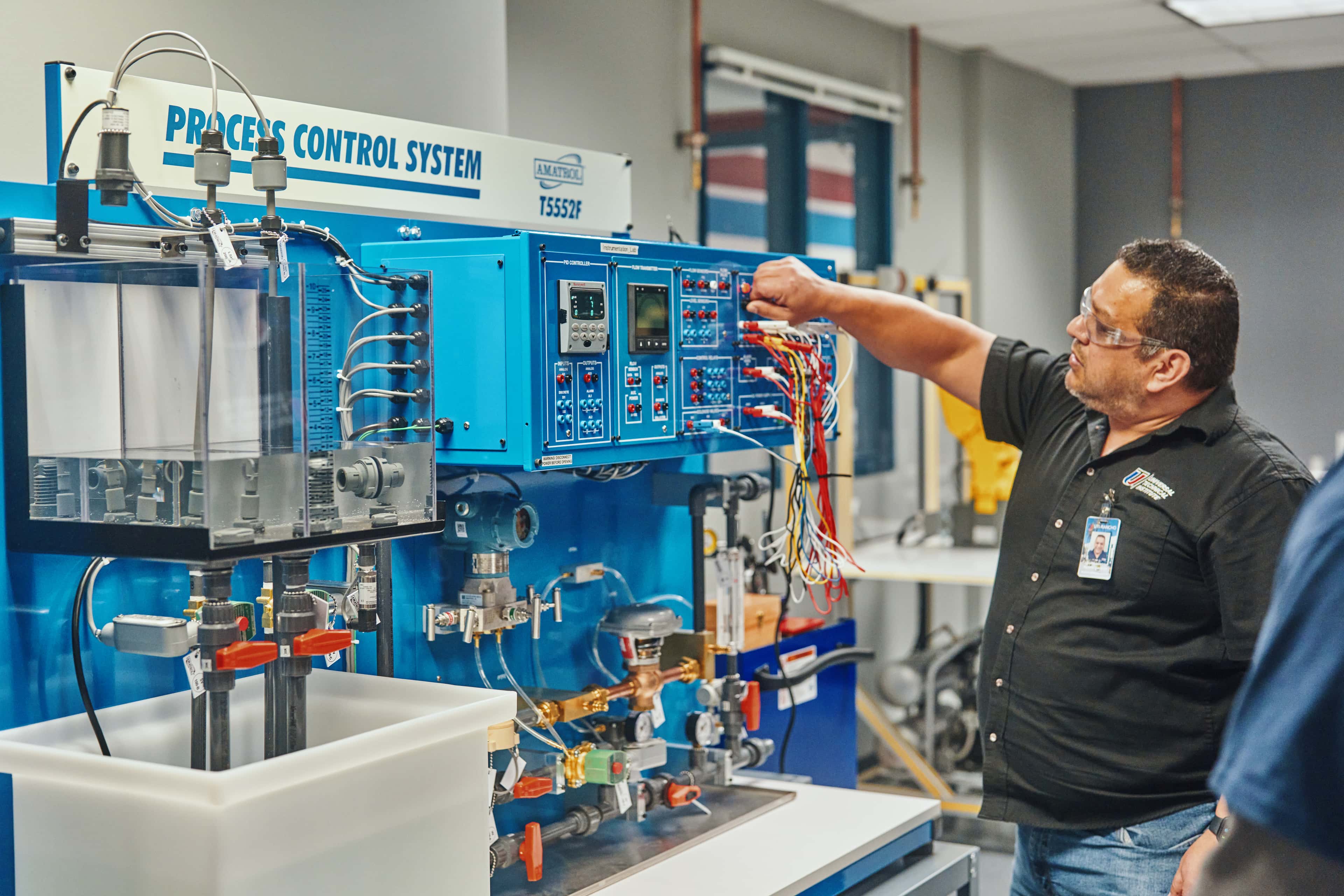Key Points:
- Robotics is a branch of technology that deals with robot design, construction, operation and use.
- Robotics is about creating machines that mimic human actions and decision-making processes to improve productivity and safety while reducing human error and cost.
- The basic parts of a robot include the control system, motors, actuators, sensors, end effectors, a power supply, a communication system and a program.
- Common types of robots include industrial, service, mobile and collaborative robots.
Robotics is a dynamic field, revolutionizing a wide range of industries. If you’re new to the world of robotics, you’re in the right place! In this blog post, we cover the basics of robotics. We'll define the basic principles of robotics, explain basic robot components, share common types of robots and more!
What Is Robotics?
Robotics is a branch of technology that deals with the design, construction, operation and use of robots. These mechanical machines are programmed to perform tasks autonomously or semi-autonomously.
Robotics integrates various fields like computer science, engineering and mathematics to create machines that can assist humans in automating otherwise dull, dirty or dangerous tasks. From manufacturing to healthcare, robots are transforming industries and making our lives more efficient.
In essence, robotics is about creating machines that can mimic human actions and decision-making processes to improve productivity and safety while reducing human error and cost. Let's explore the basic components that make up a robotic system.
8 Basic Components of a Robotic System
Different robotics systems perform different tasks and have diverse components. But, most have these basic parts in common.
1. Control system
Control systems are the brain of a robot. A programmable logic controller (PLC) is a type of control system. They use algorithms and software to dictate how a robot responds to stimuli. These systems can be as simple as a set of programmable rules or as complex as machine learning algorithms that enable robots to adapt to changes in the environment.
Control systems ensure that robots perform tasks safely and efficiently. For example, in autonomous vehicles, control systems manage everything from steering to speed control.
2. Motors
Motors in robotics convert electrical energy into rotational mechanical motion. They enable the movement of robot joints, limbs, wheels or other moving parts, allowing various tasks such as walking, gripping, lifting or rotating.
Robotics motors include DC motors, servo motors, stepper motors or brushless motors.
3. Actuators
Actuators are also responsible for movement and control. They convert electrical signals into physical actions, enabling robots to move and manipulate objects. Together, sensors and actuators help robots perceive and respond to their environment.
4. Sensors
Sensors allow robots to interact with their surroundings. Sensors gather information about the environment, such as temperature, distance and pressure. Common types of sensors include infrared, ultrasonic and LIDAR, each serving unique purposes.
5. End effectors
End effectors are the tools or devices attached to the end of a robotic arm, designed to interact with the environment. They serve as the "hands" of the robot, performing specific tasks such as gripping, welding, cutting or assembling components. End effectors can be customized for various applications, making them crucial for the robot's functionality and versatility.
6. Power supply
The power supply is the component that provides the necessary energy for a robot to operate. It can come from sources like batteries, electrical outlets or renewable energy systems.
The power supply must be reliable and sufficient to support all the robot's components, including motors, actuators, sensors and control systems. Proper power management is essential for continuous operation.
7. Communication system
A communication system exchanges information between different parts of the robot and between the robot and external systems or operators. This system can include wired or wireless connections, protocols and interfaces that facilitate seamless data transfer.
Effective communication systems accurately transmit commands, feedback, and sensor data so the robot can perform its tasks efficiently and safely.
8. Program
The program of a robotic system is a set of instructions or code that dictates the robot's actions and behaviors. Written in programming languages like Python, C++, or proprietary languages, these programs control the robot's movements, decision-making processes and interactions with its environment.
The program can be pre-installed or dynamically updated based on real-time data and feedback, enabling the robot to adapt to changing conditions and perform complex tasks autonomously.
Common Types of Robots
Engineers have taken the basic principles of robotics and continued to innovate, leading to some impressive robots. Common types include industrial, service, mobile and collaborative.
Industrial robots
Industrial robots are designed for manufacturing and production environments. They are known for their precision, speed and ability to handle repetitive tasks. Examples include articulated robots, which have rotary joints, and Selective Compliance Articulated Robot Arm (SCARA) robots, commonly used for assembly line tasks.
In factories, industrial robots perform tasks such as welding, painting and material handling. Their ability to work continuously and accurately makes them invaluable in mass production settings.
Service robots
Service robots cater to various sectors, including healthcare, hospitality and domestic services. These robots interact with humans and assist with everyday tasks. Examples include domestic robots like vacuum cleaners or medical robots used for surgeries.
In hospitals, service robots assist in surgeries by providing tools and monitoring patient vitals. These robots enhance the efficiency and precision of medical procedures, improving patient care.
Mobile robots
Mobile robots move around and perform tasks in dynamic environments. They include autonomous vehicles and drones. These robots rely on advanced navigation systems and sensors to travel and perform tasks independently.
In agriculture, mobile robots like drones monitor crop health and optimize irrigation. Their ability to cover large areas quickly and gather data makes them valuable tools for modern farming.
Collaborative robots
Collaborative robots, or cobots, are designed to work alongside humans in a shared workspace. Unlike traditional industrial robots, cobots have safety features that allow them to operate safely around people. Several industries, including manufacturing, healthcare and logistics use them.
In manufacturing, cobots assist workers by handling repetitive tasks, reducing the risk of injury and increasing productivity. Their ability to work alongside humans makes them versatile and adaptable to different work environments.
Applications of Robotics
As already mentioned, the concept of robotics is making its way into several industries. Some of the most popular robotics applications include manufacturing, healthcare, agriculture, transportation and retail/e-commerce.
Manufacturing
Robots have revolutionized manufacturing by automating repetitive and dangerous tasks, increasing efficiency and reducing costs. They are used for assembly, welding, painting and quality control. In automotive manufacturing, robots handle tasks like spot welding and painting, making for a consistent and precise process.
Healthcare
In healthcare, robots assist in surgeries, rehabilitation and patient care. Surgical robots provide precision and control, reducing the risk of complications. Rehabilitation robots help patients regain mobility and strength. For instance, robotic exoskeletons assist patients with mobility impairments, enabling them to walk and perform daily activities.
Agriculture
Robots are transforming agriculture by automating labor-intensive and time-consuming tasks like planting, harvesting and monitoring crops. They increase efficiency, reduce labor costs and improve crop yields. Drones are used to monitor crop health, while robotic harvesters pick fruits and vegetables with precision.
Transportation
Autonomous vehicles and drones are changing the transportation industry. Self-driving cars use AI and sensors to navigate roads and traffic, reducing the risk of accidents. Drones deliver packages and monitor infrastructure, enhancing logistics and supply chain management.
Retail and e-commerce
In retail and e-commerce, robots automate tasks like inventory management, order fulfillment and customer service. Warehouse robots move and sort products, reducing the time and cost of order processing. Customer service robots assist shoppers by providing information and recommendations.
Robotics Basics FAQs
Is robotics hard to learn?
Learning robotics can be challenging, but it's doable with the right resources and dedication. Some educational institutions offer basic robotics courses to get you started.1
What is the best age to start robotics?
There's no specific age to start learning robotics. Many educational programs introduce robotics to students in elementary and middle school. High school students can explore more advanced topics and participate in robotics competitions. If you’re interested in robotics but haven’t had exposure, attending a robotics training program that builds students’ knowledge from the ground up can help!
What programming languages are used in robotics?
Common programming languages used in robotics include Python, C++, and Java. Python is popular for its simplicity and versatility, making it ideal for beginners. C++ is used for performance-critical applications, while Java is known for its portability and ease of use.
How to Get Started in Robotics
From its core components to its diverse applications, robotics is shaping industries and transforming lives. As you start to pursue a robotics and automation career, remember that education and practical experience are key.
Universal Technical Institute's 51-week Robotics and Automation Technician program offers an excellent starting point, equipping you with the essential skills and knowledge to pursue a career in robotics and automation. We start with robotics basics and then advance into teaching the skills employers are looking for in entry-level candidates at all of our robotics and automation school locations.
Ready to take the next step? Request more information to speak to an Admissions Representative!
Universal Technical Institute of Illinois, Inc. is approved by the Division of Private Business and Vocational Schools of the Illinois Board of Higher Education.

